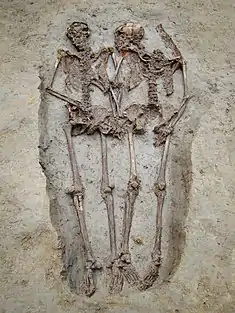Lovers of Modena
The Lovers of Modena are a pair of human skeletons discovered in 2009 by archaeologists in present-day Modena, Italy. The two skeletons were buried with their hands interlocked and are believed to have been buried between the 4th and 6th century CE.[1] Originally it was assumed that the two were composed of a male and a female, but upon scientific analysis of enamel peptides by the University of Bologna it was confirmed that the skeletons belong to two males.[2] The pair are now on display at the Civic Museum of Modena.

The relation of the two males is a unknown, but one of the researchers from the University of Bologna, Federico Lugli, suggested that rather than lovers they could have been brothers, cousins, or soldiers; he is quoted as saying in Italian, "The burial of two men hand in hand was certainly not a common practice in late antiquity.... In late ancient times it is unlikely that a homosexual love could be recognized so clearly by the people who prepared the burial.... Given that the two individuals are of similar ages, they could be relatives--for example, brothers or cousins, or soldiers who died together in battle: the necropolis where they were found could be a war cemetery”.[3]

See also
References
- "Lovers of Modena skeletons holding hands were both men". BBC News. 2019-09-12. Retrieved 2021-07-23.
- Lugli, Federico; Di Rocco, Giulia; Vazzana, Antonino; Genovese, Filippo; Pinetti, Diego; Cilli, Elisabetta; Carile, Maria Cristina; Silvestrini, Sara; Gabanini, Gaia; Arrighi, Simona; Buti, Laura (2019-09-11). "Enamel peptides reveal the sex of the Late Antique 'Lovers of Modena'". Scientific Reports. 9 (1): 13130. Bibcode:2019NatSR...913130L. doi:10.1038/s41598-019-49562-7. ISSN 2045-2322. PMC 6739468. PMID 31511583.
- "Gli Amanti di Modena sepolti mano nella mano erano due uomini. Fidanzati, soldati o fratelli?". Rainews (in Italian). Retrieved 2021-07-23.